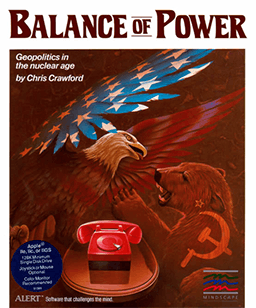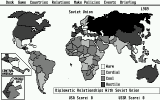Balance of Power (video game)
| Balance of Power | |
|---|---|
 Cover art | |
| Developer(s) | Chris Crawford |
| Publisher(s) | Mindscape |
| Series | Balance of Power |
| Engine | Proprietary |
| Platform(s) | Windows, Apple Macintosh, Amiga, Atari ST, Apple IIGS, MSX, Apple II |
| Release date(s) | February 1985 |
| Genre(s) | Government simulation game |
| Mode(s) | Single-player, Hotseat |
| Distribution | Floppy disk |
Balance of Power is a computer strategy game of geopolitics during the Cold War, created by Chris Crawford and published in 1985. The game is notable for engaging the player in brinkmanship.
Gameplay

The goal of the game is simple: the player may choose to be either the President of the United States or the General Secretary of the Communist Party of the Soviet Union, and must lead the chosen superpower for eight years, seeking to maximize "prestige" and avoiding a nuclear war. Each turn is one year long; at the beginning of each year, the player is presented with a set of incidents and crises in various countries around the globe, and must choose a response to each one. Responses may range from no action, to diplomatic notes to the other superpower, to military maneuvers. Each response is then met with a counter-response, which may vary from backing down to escalation. The player then gets a chance to initiate actions, and deal with the opponent's responses.
This core mechanic is similar to that of Bruce Ketchledge's 1983 game Geopolitique 1990, published by SSI. One difference from the earlier game is how negotiations are resolved. In both games, backing down in a negotiation results in a loss of prestige, which will reverberate politically. Likewise, in both games brinkmanship may result in a global war. In Geopolitique, such wars were actually fought in-game, after which the game continued. In Balance of Power, such a war ends the game instantly, with the following message: "You have ignited a nuclear war. And no, there is no animated display of a mushroom cloud with parts of bodies flying through the air. We do not reward failure."
Development
In 1984 Crawford stated at Origins Game Fair that he was "working on a game for the Macintosh entitled ARMS RACE based on the philosophy that 'H-bombs don't kill people, Geopolitics kills people.'"[1]
Crawford had difficulty in finding a publisher for Balance of Power. Random House agreed to publish it but canceled the contract and demanded that Crawford return its $10,000 advance payment, almost causing him to lose his home.[2] The game was released by Mindscape for the Apple Macintosh and Apple II, then ported to Windows (1986), Atari ST (1987) and Amiga. It was a sensation when it came out, but as a brutally realistic (some would say cynical) depiction of superpower maneuvering. In 1986, Crawford published a book also called Balance of Power, which goes into great depth on the game, including the background of the politics, the formulas used to calculate prestige and related parameters, and an account of its (lengthy) gestation.
In 1989, a second edition, dubbed Balance of Power: The 1990 Edition (sometimes referred to as Balance of Power II) was released for the Apple IIGS, Windows, Macintosh, Amiga and Atari ST. The video game industry considers it a sequel, but Crawford himself does not. It adds more countries, advisors to help out the player, a new "multi-polar" level that allows countries to generate events of their own (such as declaring war on other countries), and a few miscellaneous features including a 2 player Hotseat mode. However, with the ending of the Cold War, interest declined.
Sequel
Chris Crawford in 1992 made the "Dragon Speech" where he explained that he was going to leave the game industry to make something more interactive and artistic. After all these years working, he released the sequel to Balance of Power called Balance of Power: 21st Century, where instead of a Cold War scenario it has a scenario of a modern USA vs Asia vs the Middle East with the game's plot beginning September 12, 2001 and with the player taking the role of US President.
Since 2007 there have been forum games titled Balance of Power and based on the video game, most having a Cold War theme. The most notable place for them has been eRegime.
Reception
Computer Gaming World stated that Balance of Power "stands in a prestigious circle: that of the most innovative computer games of all time. If there were Academy Awards for computer games, BOP would get my votes for Best Picture and Best Director of 1985".[3] A 1992 survey in the magazine of wargames with modern settings gave the game four stars out of five.[4] Dragon recommended the game and called it a "superb game of global strategy that goes beyond other games, wherein thoughtful, calculated geopolitics could prevent a worldwide nuclear war!"[5] as well as "a truly entertaining and thought-provoking simulation of world geopolitics which involves the player in a quest to prevent a worldwide nuclear holocaust, while promoting either the U.S.A. or Russia to world prominence. This is a marvelous program that everyone should experience at least once."[6]
Compute! presented opposing views of the game in May 1988. The magazine included Balance of Power in its list of "Our Favorite Games", calling it "an impressive recreation of the world's geopolitical landscape ... call one too many bluffs and you'll see the chilling message You have ignited a nuclear war".[7] Orson Scott Card, however, wrote in his review of the game that Crawford—"the best designer of simulation games I've seen"—was "leaning over your shoulder and bullying you into playing the game his way. He has a sweet delusion that as long as the United States is very nice and doesn't do anything to offend them, the Russians will go home. And if you don't play that way, why, he'll stop the game with a nasty remark about how the world was just destroyed by nuclear war". He added that since no nuclear war had been fought Crawford could not know what would cause one, and "there are a lot of experts who claim that the Soviets seem to behave a lot nicer when we stand up to them than when we disarm", but that "[Crawford] is so sure he's right that Balance of Power isn't a game, it's propaganda".[8]
In 1989 Compute! stated that the 1990 edition's multipolar features were welcome additions to the game.[9] That year Card stated that the magazine's 1988 list caused him to reevaluate the game when playing the 1990 edition, stating that it had "the most detailed, carefully extrapolated future world I've worked with". While still criticizing geopolitical "absurdities" such as forcing the United States to passively accept Soviet troops in Syria (contrary to what happened during the Yom Kippur War) and advisors in Mexico or start nuclear war, Card now concluded that such outcomes probably reflected computer limitations rather than Crawford's political views. He advised players to pretend that Balance of Power was set on an alien planet "astonishingly similar" to Earth, and to play solely based on the game's assumptions about the world.[10] Chuck Moss disagreed with Card's revised view, describing Balance of Power in Computer Gaming World in 1992 as "reflect[ing] extreme bias on the part of [its] designers". He called it a "pacific treatise ... nuclear war erupted if the U.S. so much as sent five million dollars to Panama".[11] In 2014 historian Jimmy Maher wrote of the game's "We do not reward failure" nuclear-war ending, "speaking here as someone who is quite sympathetic to Crawford’s agenda[, it's] kind of disingenuous and unfair and, well, just kind of cheap", noting that the game requires brinkmanship to win but "Nuclear war, when it comes, can seem almost random, arising from a seemingly innocuous exchange after half a dozen computerized Cuban Missile Crises have passed harmlessly".[12]
Crawford stated in 1987 that he was most proud of his work on the game: "I feel [it] has made the world a better place ... I think it has made a small number of people much more realistic in their appraisal of world affairs".[2] In 1996 Computer Gaming World ranked it as the 78th best game of all time, calling it "a wonderful game of political intrigue that felt just like the Cold War and didn't require the detail of Shadow President or CyberJudas."[13] That same year, it was ranked as the 75th top game of all time by Next Generation.[14]
See also
- Balance of power in international relations
- Brinkmanship (Cold War)
References
- ↑ "The CGW Computer Game Conference". Computer Gaming World (panel discussion). October 1984. p. 30. Retrieved October 31, 2013.
- ↑ 2.0 2.1 "Designer Profile: Chris Crawford (Part 2)". Computer Gaming World. Jan–Feb 1987. pp. 56–59. Retrieved 1 November 2013.
- ↑ Boosman, Frank C. (May 1986). "Macintosh Window". Computer Gaming World. pp. 18, 45. Retrieved November 1, 2013.
- ↑ Brooks, M. Evan (June 1992). "The Modern Games: 1950 - 2000". Computer Gaming World. p. 120. Retrieved November 24, 2013.
- ↑ Lesser, Hartley and Pattie (June 1986). "The Role of Computers". The Dragon (110): 38–43.
- ↑ Lesser, Hartley and Pattie (December 1986). "The Role of Computers". Dragon (116): 69–76.
- ↑ "Our Favorite Games". Compute!. May 1988. p. 12. Retrieved November 10, 2013.
- ↑ Card, Orson Scott (May 1988). "Do You Want to Change the World? Two Games Let You Try". Compute!. p. 9. Retrieved November 10, 2013.
- ↑ Keizer, Gregg (January 1989). "Balance of Power: The 1990 Edition". Compute!. p. 80. Retrieved November 10, 2013.
- ↑ Card, Orson Scott (June 1989). "Light-years and Lasers / Science Fiction Inside Your Computer". Compute!. p. 29. Retrieved November 11, 2013.
- ↑ Moss, Chuck (November 1992). "Spectrum Holobyte's Crisis in the Kremlin". Computer Gaming World. p. 34. Retrieved 4 July 2014.
- ↑ Maher, Jimmy (2014-02-28). "Macware". The Digital Antiquarian. Retrieved 11 July 2014.
- ↑ CGW 148: 150 Best Games of All Time
- ↑ Next Generation 21 (September 1996), p.48.
External links
- Chris Crawford, Balance of Power (Microsoft Press, 1986)
- Balance of Power 1990, link to game provided by Abandonia
- PC Retroview: Balance of Power by IGN